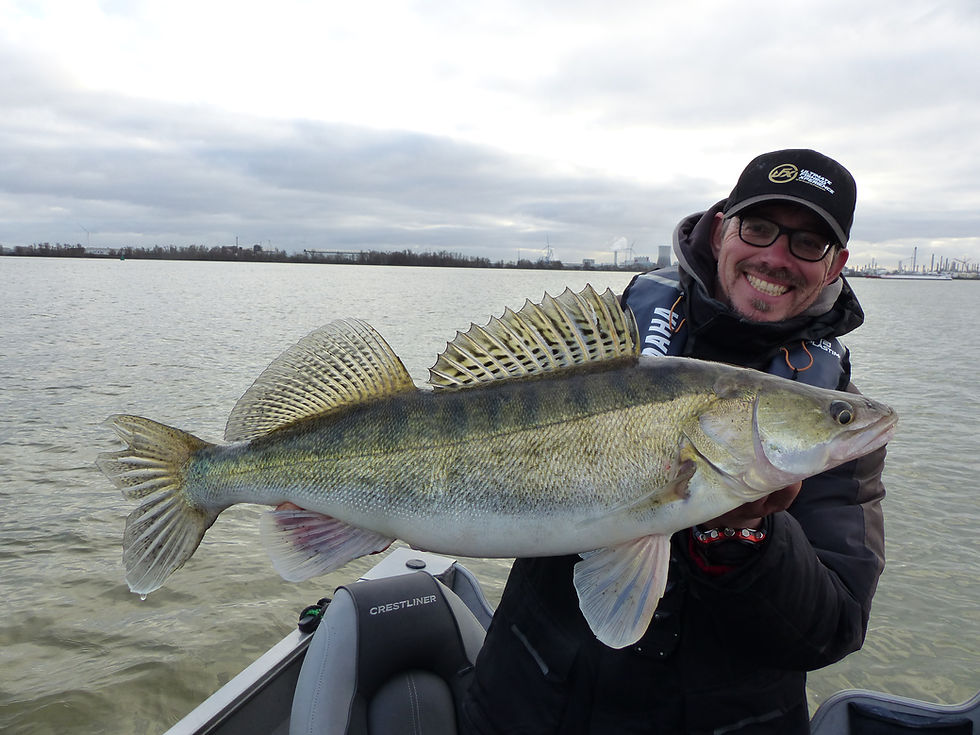Long line zander
- Thom Prüst
- Nov 30, 2022
- 4 min read
It's the time of year that zander fishing is The Bomb. The fish are slowing down, angling has to be precise and the reward comes with big fat zander.

First some non scientific, but only practise and personal belief based theory. Coming autumn/ early winter, I store my casting rods and dig up the vertical fishing stuf. When the water gets colder I find it harder and harder to catch zander "casting". I can't really explain why, because the way I lead my lure across the bottom is virtually the same as in the tecnnique I am about to discuss. When casting: I want to get my lure down asap (i.e. 15-20 grams jighead) and, while keeping my rod down (directed to the water), I try to keep my lure as long as possible about 3-5 cm lifted from the bottom while never losing contact with my softbait. Until early November for me this is the way to go to catch zander. However, as the water gets colder this technique becomes less and less successful. I always thought that due to a low temperatures the fish are getting slower and that 'casting' resulted in a too fast fished softbait. My guess now however is that the fish due to the dropping temperatures are more 'stationary' and that 'casting' simply doesn't cover enough water.
It's not the speed that's the problem early winter.

So, what technique makes the magic happen in winter? The answer is: long line jigging. Which is basically nothing more than dragging a softbait lifted about 3-5 cm from the ground across the bottom while holding it as still as possible. And the weird thing is, you can do this dragging pretty fast: 2-3 km/h is no problem for a zander. It's more a problem for the angler as the faster you go, the more difficult it is to keep your lure in the strike zone.
High speed is more an angler's problem than a fish's problem.
Long line jigging setup. For this technique I prefer to use a vertical rod of 2 meters with fast or extra fast action and a (max.) lure weight of something around 20 grams. For line I use a braided PE-line of 0.12 mm and a fluor carbon leader of 0.30-0.35 mm. We top this setup off with a 12-14 cm softbait rigged on a 28 grams 3/0 jighead and put a stinger, close to the main hook on it.

Don't mind the color, just take something you think looks beautiful. I know that I am probably the only angler in the world that doesn't believe in colors at all, but I really haven't been able to notice any difference when fishing. I just catch with whatever lure I put on, it's all about, and only about, the applied technique. So, take whatever you have faith in and it will work out fine.
So, now that we have the setup complete we can get to the actual long line jigging. Just start up a drift with your boat (try 1 - 1,4 km/h) , drop the lure in the water and give line until you hit the bottom. Now you lift your lure about 5 cm from the ground hold it still for a few seconds and try to make ground contact again by moving back your arm. Your arm probably isn't long enough make your lure hit the ground so give more line until you make ground contact again. Again lift the lure about 5 cm from the bottom and repeat the whole process. At some point you will notice that you can keep your lure 5 cm from the ground by moving your arm for just like 25 cm, at this point your lure is way behind the boat (hence the long line 😉) and you just try to keep it still. And here is where I tend to experiment with the softbait used, in terms of switching between paddle tails, v-tails and pintails. Depending on boat speed, current, wind, etc. the shape of your softbait makes it easier or more difficult to keep your lure at this magic position of 5 cm lifted from the ground. And now what? Now we wait. Just let your boat go, keep your lure still close to the bottom and wait for a zander to hang on it! Just one little last thing: set the hook on every single change of movement you notice on your softbait. Not only on the hard strikes but on whatever you feel. Remember: stones, plants and even the ground don't bite your lure! I think that the strength of long line jigging is being in the strike zone the whole time while covering lots of water augmenting the chance of having an encounter between your softbait and a zander. And speed seems to be irrelevant, as long as the lure just passes in front of it's nose a zander will grab it also when your lure swims by at 3 km/h.

In my experience this is by far the most successful technique in late autumn/ early winter. Although in all honesty it's one of the hardest techniques there is. Not having your lure just above the bottom will result in virtually no bites. But once you get the hang of it you will be shouting: fish on! continuously.
Are you up for some long line jigging? Book your fishing trip with Lure Fishing Guide right now.






